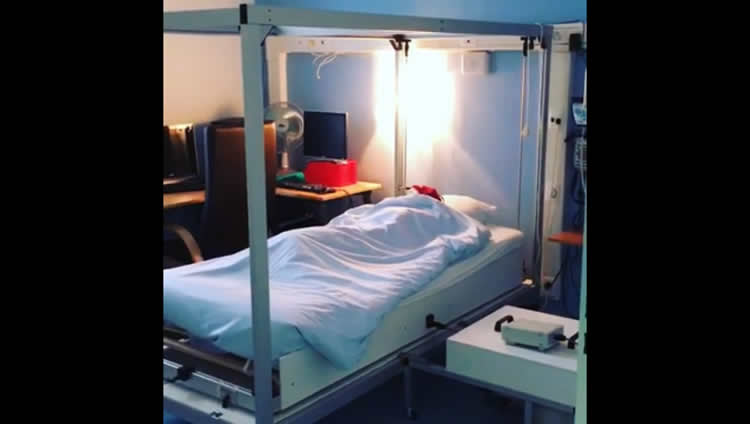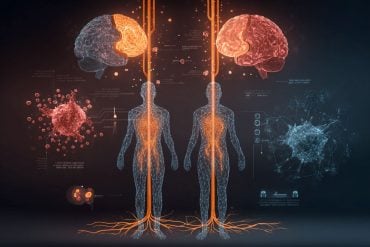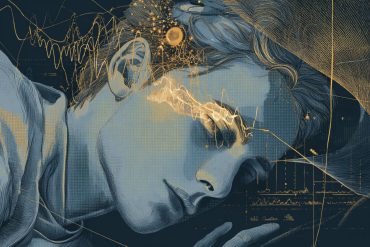Summary: A new study reveals people fall asleep faster when being rocked. Additionally, they showed improvements in memory consolidation and spent more time in non-REM sleep.
Source: Cell Press.
Anyone who has ever put a small child to bed or drifted off in a gently swaying hammock will know that a rocking motion makes getting to sleep seem easier. Now, two new studies reported in Current Biology on January 24, one conducted in young adults and the other in mice, add to evidence for the broad benefits of a rocking motion during sleep. In fact, the studies in people show that rocking not only leads to better sleep, but it also boosts memory consolidation during sleep.
“Having a good night’s sleep means falling asleep rapidly and then staying asleep during the whole night,” says Laurence Bayer of the University of Geneva, Switzerland. “Our volunteers–even if they were all good sleepers–fell asleep more rapidly when rocked and had longer periods of deeper sleep associated with fewer arousals during the night. We thus show that rocking is good for sleep.”
Bayer and their colleagues had earlier shown that continuous rocking during a 45-minute nap helped people to fall asleep faster and sleep more soundly. In the new study, led by Laurence Bayer and Sophie Schwartz, University of Geneva, Switzerland, they wanted to explore the effects of rocking on sleep and its associated brain waves throughout the night.
The researchers enlisted 18 healthy young adults to undergo sleep monitoring in the lab. The first night was intended to get them used to sleeping there. They then stayed two more nights–one sleeping on a gently rocking bed and the other sleeping on an identical bed that wasn’t moving.
The data showed that participants fell asleep faster while rocking. Once asleep, they also spent more time in non-rapid eye movement sleep, slept more deeply, and woke up less.
Next, the researchers wanted to know how that better sleep influenced memory. To assess memory consolidation, participants studied word pairs. The researchers then measured their accuracy in recalling those paired words in an evening session compared to the next morning when they woke up. They found that people did better on the morning test when they were rocked during sleep.
Further studies showed that rocking affects brain oscillations during sleep. They saw that the rocking motion caused an entrainment of specific brain oscillations of non-rapid eye movement sleep (slow oscillations and spindles). As a result, the continuous rocking motion helped to synchronize neural activity in the thalamo-cortical networks of the brain, which play an important role in both sleep and memory consolidation.
The second study in mice by Konstantinos Kompotis and colleagues is the first to explore whether rocking promotes sleep in other species. And, indeed, it did. The researchers, led by Paul Franken, University of Lausanne, Switzerland, used commercial reciprocating shakers to rock the cages of mice as they slept.
While the best rocking frequency for mice was found to be four times faster than in people, the researchers’ studies show that rocking reduced the time it took to fall asleep and increased sleep time in mice as it does in humans. However, the mice did not show evidence of sleeping more deeply.
Researchers had suspected that the effects of rocking on sleep were tied to rhythmic stimulation of the vestibular system, the sensory system that contributes to the sense of balance and spatial orientation. To explore this notion in the mouse, the researchers studied animals whose vestibular systems were disrupted by non-functioning otolithic organs, found in their ears. Their studies showed that mice lacking working otolithic organs experienced none of the beneficial effects of rocking during sleep.

Taken together, the two studies “provide new insights into the neurophysiological mechanisms underlying the effects of rocking stimulation on sleep,” Bayer and Perrault write. The findings may be relevant for the development of new approaches for treating patients with insomnia and mood disorders, as well as older people, who frequently suffer from poor sleep and memory impairments.
The researchers say it will be essential in future work to explore the precise deeper brain structures involved in the effects of rocking on sleep.
“Current tools, such as optogenetics, can help us decipher which structures, or even neuronal populations, receive the stimulus from the otolithic organs and transfer it further to the structures of the sleep circuitry,” Franken says. “Mapping the network of communication between the two systems will provide with basic understanding, as well as novel clinical targets to cope with sleep disorders, like insomnia.”
Funding: Perrault et al. was supported by the Swiss National Science Foundation and hosted by the University of Geneva.
Source: Carly Britton – Cell Press
Publisher: Organized by NeuroscienceNews.com.
Image Source: NeuroscienceNews.com image is credited to Laurence Bayer and Aurore Perrault.
Original Research: Open access research for “Whole-Night Continuous Rocking Entrains Spontaneous Neural Oscillations with Benefits for Sleep and Memory” by Aurore A. Perrault, Abbas Khani, Charles Quairiaux, Konstantinos Kompotis, Paul Franken, Michel Muhlethaler, Sophie Schwartz, and Laurence Bayer in Current Biology. Published January 24 2019.
doi:10.1016/j.cub.2018.12.028
[cbtabs][cbtab title=”MLA”]Cell Press”Rocking Improves Sleep and Memory in Both People and Mice.” NeuroscienceNews. NeuroscienceNews, 224 January 2019.
<https://neurosciencenews.com/rocking-sleep-memory-10629/>.[/cbtab][cbtab title=”APA”]Cell Press(2019, January 224). Rocking Improves Sleep and Memory in Both People and Mice. NeuroscienceNews. Retrieved January 224, 2019 from https://neurosciencenews.com/rocking-sleep-memory-10629/[/cbtab][cbtab title=”Chicago”]Cell Press”Rocking Improves Sleep and Memory in Both People and Mice.” https://neurosciencenews.com/rocking-sleep-memory-10629/ (accessed January 224, 2019).[/cbtab][/cbtabs]
Abstract
Whole-Night Continuous Rocking Entrains Spontaneous Neural Oscillations with Benefits for Sleep and Memory
Sensory processing continues during sleep and can influence brain oscillations. We previously showed that a gentle rocking stimulation (0.25 Hz), during an afternoon nap, facilitates wake-sleep transition and boosts endogenous brain oscillations (i.e., EEG spindles and slow oscillations [SOs]). Here, we tested the hypothesis that the rhythmic rocking stimulation synchronizes sleep oscillations, a neurophysiological mechanism referred to as “neural entrainment.” We analyzed EEG brain responses related to the stimulation recorded from 18 participants while they had a full night of sleep on a rocking bed. Moreover, because sleep oscillations are considered of critical relevance for memory processes, we also investigated whether rocking influences overnight declarative memory consolidation. We first show that, compared to a stationary night, continuous rocking shortened the latency to non-REM (NREM) sleep and strengthened sleep maintenance, as indexed by increased NREM stage 3 (N3) duration and fewer arousals. These beneficial effects were paralleled by an increase in SOs and in slow and fast spindles during N3, without affecting the physiological SO-spindle phase coupling. We then confirm that, during the rocking night, overnight memory consolidation was enhanced and also correlated with the increase in fast spindles, whose co-occurrence with the SO up-state is considered to foster cortical synaptic plasticity. Finally, supporting the hypothesis that a rhythmic stimulation entrains sleep oscillations, we report a temporal clustering of spindles and SOs relative to the rocking cycle. Altogether, these findings demonstrate that a continuous rocking stimulation strengthens deep sleep via the neural entrainment of intrinsic sleep oscillations.






